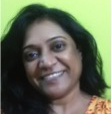Arogya World Fellow Mallika Rao interviewed Nandini Ganesh.
 Former information technology professional Nandini Ganesh joined the Arogya World team in August of 2012 after a 10-year career at global software company Sonata Software Limited. Since then, her experience has transformed her knowledge of noncommunicable diseases (NCDs) for the better. She shared her thoughts on why she believes Arogya World is doing wonders in raising awareness of NCDs in her native India.
Former information technology professional Nandini Ganesh joined the Arogya World team in August of 2012 after a 10-year career at global software company Sonata Software Limited. Since then, her experience has transformed her knowledge of noncommunicable diseases (NCDs) for the better. She shared her thoughts on why she believes Arogya World is doing wonders in raising awareness of NCDs in her native India.
Tell me about your role in Arogya World and how you got involved.
I got involved in Arogya World through Dr. Geeta Bharadwaj (Head of the Healthy Workplace Initiative), who wanted someone to work in Bangalore. To be quite frank, I was interested in the role because I love giving back through my work. I held a part-time job in social services once, and I love that line of work. Through my work, I help people in the area by coordinating meetings and doing administrative work for Healthy Workplaces. I also train children in the Healthy Schools program, which is one of my favorite things to do, and I also help the Arogya team with work on the myArogya app and mDiabetes.
How has your experience shaped your understanding of NCDs?
As someone in the general public, I only knew what I heard through word of mouth and through Google, and I only knew the basics of each of these diseases. Now, I have learned that there are so many things we can do to prevent NCDs. I did not have much information about that before. As with anything, once you get started working somewhere, you learn more than you did before.
How has this cause touched your life personally?
I have family members who have suffered from cancer, and my work at Arogya is definitely more personal because of this. It is still difficult to go through, but my work at Arogya has made it easier for me to handle these challenges.
How has Arogya World changed the conversation on NCD prevention?
Arogya has done a wonderful job informing people on the prevention of these diseases. We knew more about NCDs before, but we didn’t know how to practically go about managing them. Now, we know it’s as simple as diet and exercise.
